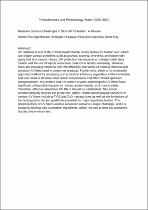JavaScript is disabled for your browser. Some features of this site may not work without it.
- ResearchSpace
- →
- Research Publications/Outputs
- →
- Journal Articles
- →
- View Item
| dc.contributor.author |
Egambaram, Orielia P

|
|
| dc.contributor.author |
Kesavan Pillai, Sreejarani

|
|
| dc.contributor.author |
Ray, Suprakas S

|
|
| dc.date.accessioned | 2020-09-08T07:43:03Z | |
| dc.date.available | 2020-09-08T07:43:03Z | |
| dc.date.issued | 2020-03 | |
| dc.identifier.citation | Egambaram, O.P., Kesavan Pillai, S. and Ray, S.S. 2020. Materials science challenges in skin UV protection: A review. Photochemistry and Photobiology, v96(4), 779-797. | en_US |
| dc.identifier.issn | 0031-8655 | |
| dc.identifier.issn | 1751-1097 | |
| dc.identifier.uri | https://pubmed.ncbi.nlm.nih.gov/31886889/ | |
| dc.identifier.uri | https://doi.org/10.1111/php.13208 | |
| dc.identifier.uri | https://onlinelibrary.wiley.com/doi/full/10.1111/php.13208 | |
| dc.identifier.uri | http://hdl.handle.net/10204/11571 | |
| dc.description | Copyright: 2020 American Society for Photobiology. This is the abstract version of the work. For access to the full text, kindly contact the publisher's website | en_US |
| dc.description.abstract | UV radiation is one of the critical environmental stress factors for human skin, which can trigger various problems such as pruritus, burning, erythema, premature skin aging and skin cancer. Hence, UV protection has become an indispensable daily routine and the use of topical sunscreen products is rapidly increasing. However, there are emerging concerns over the efficiency and safety of existing chemical and physical UV filters used in consumer products. Furthermore, there is no universally approved method for assessing sun protection efficiency regardless of the immediate end user need to develop safer sunscreen products that afford broad-spectrum photoprotection. It is evident that the current organic and inorganic UV filters have significant unfavorable impacts on human, environmental, and marine safety. Therefore, effective alternative UV filters should be established. This article comprehensively reviews the properties, safety, health and ecological concerns of various UV filters including TiO2 and ZnO nanoparticles as well as the limitations of the testing protocols and guidelines provided by major regulatory bodies. The photoreactivity of UV filters used in sunscreen remains a major challenge, and it is crucial to develop new sunscreen ingredients, which not only protect the consumer, but also the environment. | en_US |
| dc.language.iso | en | en_US |
| dc.publisher | American Society for Photobiology | en_US |
| dc.relation.ispartofseries | Worklist;23654 | |
| dc.subject | Ultraviolet radiation | en_US |
| dc.subject | UV radiation | en_US |
| dc.subject | Skin cancer | en_US |
| dc.title | Materials science challenges in skin UV protection: A review | en_US |
| dc.type | Article | en_US |
| dc.identifier.apacitation | Egambaram, O. P., Kesavan Pillai, S., & Ray, S. S. (2020). Materials science challenges in skin UV protection: A review. http://hdl.handle.net/10204/11571 | en_ZA |
| dc.identifier.chicagocitation | Egambaram, Orielia P, Sreejarani Kesavan Pillai, and Suprakas S Ray "Materials science challenges in skin UV protection: A review." (2020) http://hdl.handle.net/10204/11571 | en_ZA |
| dc.identifier.vancouvercitation | Egambaram OP, Kesavan Pillai S, Ray SS. Materials science challenges in skin UV protection: A review. 2020; http://hdl.handle.net/10204/11571. | en_ZA |
| dc.identifier.ris | TY - Article AU - Egambaram, Orielia P AU - Kesavan Pillai, Sreejarani AU - Ray, Suprakas S AB - UV radiation is one of the critical environmental stress factors for human skin, which can trigger various problems such as pruritus, burning, erythema, premature skin aging and skin cancer. Hence, UV protection has become an indispensable daily routine and the use of topical sunscreen products is rapidly increasing. However, there are emerging concerns over the efficiency and safety of existing chemical and physical UV filters used in consumer products. Furthermore, there is no universally approved method for assessing sun protection efficiency regardless of the immediate end user need to develop safer sunscreen products that afford broad-spectrum photoprotection. It is evident that the current organic and inorganic UV filters have significant unfavorable impacts on human, environmental, and marine safety. Therefore, effective alternative UV filters should be established. This article comprehensively reviews the properties, safety, health and ecological concerns of various UV filters including TiO2 and ZnO nanoparticles as well as the limitations of the testing protocols and guidelines provided by major regulatory bodies. The photoreactivity of UV filters used in sunscreen remains a major challenge, and it is crucial to develop new sunscreen ingredients, which not only protect the consumer, but also the environment. DA - 2020-03 DB - ResearchSpace DP - CSIR KW - Ultraviolet radiation KW - UV radiation KW - Skin cancer LK - https://researchspace.csir.co.za PY - 2020 SM - 0031-8655 SM - 1751-1097 T1 - Materials science challenges in skin UV protection: A review TI - Materials science challenges in skin UV protection: A review UR - http://hdl.handle.net/10204/11571 ER - | en_ZA |






